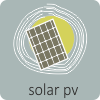Hydro energy is power derived from the energy of running or falling water on an energy conversion equipment (turbine or wheel). These energy conversion equipment converts the kinetic energy into mechanical energy, which is further converted to electrical energy by means of a generator. The scale of a hydro-power project ranges from 10 W to more than 100 MW. There are no international classification on hydro-power projects but theoretically, hydro-power projects can be classified under 6 broad categories namely:
- Large-hydro – Projects around 100 MW more power generation capacity fall under this category. Such projects are used for large scale electricity generation for large electricity grid.
- Medium-hydro – Projects around 10 MW to 100 MW power generation capacity fall under this category. Such projects are used for mid-scale electricity generation for mid-scale electricity grid.
- Small-hydro – Projects around 1 MW to 10 MW power generation capacity fall under this category. Such projects are used for small-scale electricity generation for small electricity grid.
- Mini-hydro – Projects around 100 kW to 1 MW power generation capacity fall under this category. Such projects are used as a stand-alone project. However, based on requirement, the same could also be used to feed in grid.
- Micro-hydro – Projects around 5 kW to 100 kW power generation capacity fall under this category. Such stand-alone projects are applicable to small scale requirement of a community or rural industries in remote areas.
- Pico-hydro— Projects around 5 W to 5 kW power generation capacity fall under this category. Such stand-alone projects are applicable localized requirement of battery charging or food processing.
Hydro energy has become a major source of electricity generation. Hydro power plants are of three types, namely:
- Impoundment
These are typically large hydro power systems. A dam is required to store water in a reservoir. Water on being released passes through a turbine, thereby spinning it. The spinning turbine activates a generator which in turn produces electricity. This is the most common hydroelectric power plant.
- Diversion
These are run of the river hydro power plants. A portion of the river is channelled through a canal which then falls on a turbine. These power plants do not require a dam for their operation.
- Pumped Storage
The pumped storage hydro power plants work as a battery. They usually have two reservoirs at different heights. When there is a low demand for electricity, a pumped storage pumps water from the lower reservoir to the higher reservoir. The water in the higher reservoir is released when there is a demand for electricity. The released water spins a turbine which in turn activates a generator and produces electricity.
Hydro-power could be one of the most economical, reliable, and renewable source of energy which could work around the clock with any major variation during the day or seasons. However, the planning, design, and execution of a hydro-power plant requires a special attention in every phase of the project. Once installed, the life period of a hydro-plant is more than 30 years. Other key advantages are quick to start-up and shut-down in response to the demand. On the other hand, hydro-power plants could prove to be adverse to the local environment. Due to hydro-power plant, short stretch of by-pass river could dry out, aquatic life may be effected due to stream obstruction created by the plant, impact natural migration of fish, sinking underground levels, and adverse impact on local landscape. Thus, planning phase should evaluate and analyse the environmental impact of a hydro-plant in the location to avoid major environmental impact of the project.












